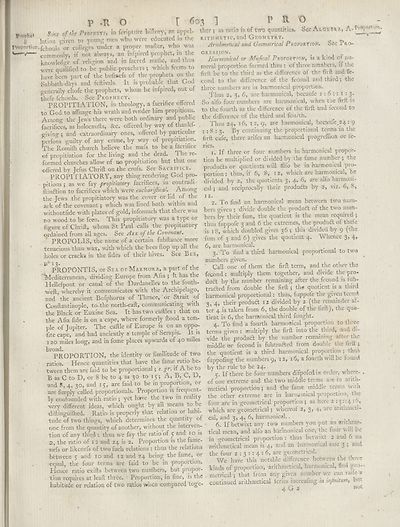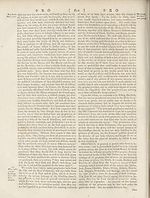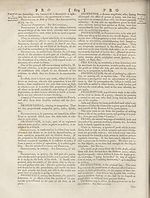Encyclopaedia Britannica > Volume 15, PLA-RAM
(671) Page 603
Download files
Complete book:
Individual page:
Thumbnail gallery: Grid view | List view

P .R O t ' 603 ] 1’ R
ftw of the Prophets, in fcripture Wfloty, an appel- ther ; as ratio w of two quantities,
lation given to young men who were educated in the
J’roportlor.^^QQ^ or colleges under a proper mailer, who was
* 1 commonly, if not always, an infpired prophet, in the
o
Prophet
knowledge of religion and in facred mulic, and thus
were qualified to be public preachers ; which feuus to
have been part of the bnfmefs of the prophets on the
Sabbath-days and feftivals. It is probable that God
generally chofe the prophets, whom he infpired, out of
thefe fchools. See Prophecy.
PROPITIATION, in theology, a facrifice offered
to God to affuage his wrath and render him propitious.
Among the Jews there were both ordinary and public
facrilices, as holocauffs, &c. offered by way of thanki-
giving ; and extraordinary ones, offered by particular
perfons guilty of any crime, by way of propitiation.
The Romifh church believe the mafs to be a facrifice
of propitiation for the living and the dead, 1 he le-
formed churches allow of no propitiation but that one
offered by Jefus Chrift on the crofs. See Sacrifice.
PROPITIATORY, any thing rendering God pro¬
pitious ; as we fay propitiatory facrifices, in contradi-
ilinftion to facrifices which were euchariftica!. Among
the Jews the propitiatory was the cover or lid of the
ark of the covenant ; which was lined both within and
withoutiide with plates of gold, infomuch that there .was
no wood to be feen. This propitiatory was a type or
figure of Chrift, whom St Paul calls the propitiatory
ordained from all ages. See Ark of the Covenant.
PROPOLIS, tiie name of a certain fubftance more
tenacious than wax, with which the bees Hop up all the
holes or cracks in the fides of their hives. See Lee,
- U° 1 3. f ,
PROPONTIS, or Sea of Marmora, a part of the
Mediterranean, dividing Europe from Alia ; it has the
Hellefpont or canal of the Dardanelles to the fouth-
weft, whereby it communicates with the Archipelago,
and the ancient Lofphorus of 1 brace, or Strait of
Conftantinople, to-the north-eaft, communicating with
the Black or Euxine Sea. It has two caftles : that on
the Afia fide is on a cape, where formerly flood a tem¬
ple of Jupiter. The caftle of Europe is on an oppo-
iite cape, and had anciently a temple of Serapis. It is
120 miles long, and in fome places upwards of 40 miles
broad. „
PROPORTION, the identity or fimilitude of two
ratios. Hence quantities that have the fame ratio be¬
tween them are faid to be proportional; e. gr. it Abe to
B as C to D, or 8 be to 4 as 30 to 15; A, B, C, D,
and S, 4, 30, and 15, are faid to be in proportion, or
are fimply called proportionals. Proportion is frequent¬
ly confounded with ratio ; yet have the two in reality
very different ideas, which ought by all means to be
diftinguifhed. Ratio is properly that relation or habi¬
tude of two things, which determines the quantity of
one from the quantity of another, without the interven¬
tion of any third : thus we fay the ratio of 5 and 1 o is
2, the ratio of 12 and 24 is 2. Proportion is the fame-
nefs or likenefs of two fuch relations : thus the relations
between 5 and 10 and 12 and 24 being the fame,, or
equal, the four terms are faid to be in proportion.
Hence ratio exifts between two numbers, but propor¬
tion requires at leaft three. Proportion, in fine, is the
habitude or relation of two ratios when compared toge-
See Algebra, A-Prtfpnrtir^.
rithmetic, and Geometry.
Arithmetical and Geometrical Proportion, bee Pro¬
gression.
Harmohical or Mujkal Proportion, is a k^ntl of nu¬
meral proportion formed thus : of three mnnbers, if the
firft be to the third as the difference of the firft and fe-
cond to the difference of the fecond and third; the
three numbers are in harmonical proportion.
Thus 2, 3, 6, are harmonical, becaufe 2:6:: 1:3-
So alfo four numbers are harmonica!, when tne firft is
to the fourth as the difference of the firft and fecund to
the difference of the third and fourth.
Thus 24, 16, 12, 9, are harmonical, becaufe 24: 9
: : 8 : 3. By continuing the proportional terms in the
firft cafe, there arifes an harmonical progreffion or ie-
ries.
1. If three or four numbers in harmomcal propor¬
tion be multiplied or divided by the lame number ; the
products or quotients will alfo be in harmonical pro¬
portion: thus, if 6, 8, 12, which are harmonical, be
divided by 2, the quotients 3, 4, 6, are alfo harmoni¬
ca! ; and reciprocally their products by 2, viz. 6, 8,
12.
2. To find an harmonical mean between two num¬
bers given 5 divide double the product of the two num¬
bers by their fum, the quotient is the mean required ;
thus fuppofe 3 and 6 the extremes, the prodtift of thefe
is 18, which doubled gives 36 ; this divided by 9 (the
fum of 3 and 6) gives the quotient 4. Whence 3, 4,
6, are harmonical.
3. To find a third harmonical proportional to two
numbers given.
' Call one of them the firft term, and the other the
fecund : multiply them together, and divide the pro*
duft by the number remaining after the fecond is iub-
tracled from double tbe firft ; the quotient is a third
harmonical proportional: thus, fuppoie the given tem^
3, 4, their produd 12 divided by 2 (the remainder af¬
ter 4 is taken from 6, the double of the iirft), the qu«-
tient is 6, the harmonical third fought.
4. To find a fourth harmonical proportion to three
terms given : multiply the firft. into the liiird, and di¬
vide the produd by the number remaining after the
middle or fecond is fubtraded from double the firft ;
the quotient is a third harmonical proportion ; thus
fuppofing the numbers 9, 12, 16, a fourth will be found
by the rule to be 24.
5. If there be four numbers d.’fpofedm order, where- .
of one extreme and the two middle terms are in arith¬
metical proportion ; and the fame .middle terms with
the other extreme are in harmonical proportion, the
four are in geometrical proportion ; as here 2 13 :: 4 :6,
which are geometrical; whereof 2, 3> 4> ure arit!micti-
cal, and 3, 4, 6, harmonical..
6. If betwixt any two numbers you put an anthmtN
tical mean, and alfo an harmonical one, the lour will be
in geometrical proportion : thus betwixt 2 and 6 an
arithmetical mean is 4* nnd an harmonical one 3 5 nnd
the four 2:3114*^’ are geome^riC
We have this notable difference between the three
kinds of proportion, arithmetical, harmonical, 5nd geo-*
metrical; that from any given number we can raife a
continued arithmetical feries increafing in infinitum, bn*'
4 G 2
ftw of the Prophets, in fcripture Wfloty, an appel- ther ; as ratio w of two quantities,
lation given to young men who were educated in the
J’roportlor.^^QQ^ or colleges under a proper mailer, who was
* 1 commonly, if not always, an infpired prophet, in the
o
Prophet
knowledge of religion and in facred mulic, and thus
were qualified to be public preachers ; which feuus to
have been part of the bnfmefs of the prophets on the
Sabbath-days and feftivals. It is probable that God
generally chofe the prophets, whom he infpired, out of
thefe fchools. See Prophecy.
PROPITIATION, in theology, a facrifice offered
to God to affuage his wrath and render him propitious.
Among the Jews there were both ordinary and public
facrilices, as holocauffs, &c. offered by way of thanki-
giving ; and extraordinary ones, offered by particular
perfons guilty of any crime, by way of propitiation.
The Romifh church believe the mafs to be a facrifice
of propitiation for the living and the dead, 1 he le-
formed churches allow of no propitiation but that one
offered by Jefus Chrift on the crofs. See Sacrifice.
PROPITIATORY, any thing rendering God pro¬
pitious ; as we fay propitiatory facrifices, in contradi-
ilinftion to facrifices which were euchariftica!. Among
the Jews the propitiatory was the cover or lid of the
ark of the covenant ; which was lined both within and
withoutiide with plates of gold, infomuch that there .was
no wood to be feen. This propitiatory was a type or
figure of Chrift, whom St Paul calls the propitiatory
ordained from all ages. See Ark of the Covenant.
PROPOLIS, tiie name of a certain fubftance more
tenacious than wax, with which the bees Hop up all the
holes or cracks in the fides of their hives. See Lee,
- U° 1 3. f ,
PROPONTIS, or Sea of Marmora, a part of the
Mediterranean, dividing Europe from Alia ; it has the
Hellefpont or canal of the Dardanelles to the fouth-
weft, whereby it communicates with the Archipelago,
and the ancient Lofphorus of 1 brace, or Strait of
Conftantinople, to-the north-eaft, communicating with
the Black or Euxine Sea. It has two caftles : that on
the Afia fide is on a cape, where formerly flood a tem¬
ple of Jupiter. The caftle of Europe is on an oppo-
iite cape, and had anciently a temple of Serapis. It is
120 miles long, and in fome places upwards of 40 miles
broad. „
PROPORTION, the identity or fimilitude of two
ratios. Hence quantities that have the fame ratio be¬
tween them are faid to be proportional; e. gr. it Abe to
B as C to D, or 8 be to 4 as 30 to 15; A, B, C, D,
and S, 4, 30, and 15, are faid to be in proportion, or
are fimply called proportionals. Proportion is frequent¬
ly confounded with ratio ; yet have the two in reality
very different ideas, which ought by all means to be
diftinguifhed. Ratio is properly that relation or habi¬
tude of two things, which determines the quantity of
one from the quantity of another, without the interven¬
tion of any third : thus we fay the ratio of 5 and 1 o is
2, the ratio of 12 and 24 is 2. Proportion is the fame-
nefs or likenefs of two fuch relations : thus the relations
between 5 and 10 and 12 and 24 being the fame,, or
equal, the four terms are faid to be in proportion.
Hence ratio exifts between two numbers, but propor¬
tion requires at leaft three. Proportion, in fine, is the
habitude or relation of two ratios when compared toge-
See Algebra, A-Prtfpnrtir^.
rithmetic, and Geometry.
Arithmetical and Geometrical Proportion, bee Pro¬
gression.
Harmohical or Mujkal Proportion, is a k^ntl of nu¬
meral proportion formed thus : of three mnnbers, if the
firft be to the third as the difference of the firft and fe-
cond to the difference of the fecond and third; the
three numbers are in harmonical proportion.
Thus 2, 3, 6, are harmonical, becaufe 2:6:: 1:3-
So alfo four numbers are harmonica!, when tne firft is
to the fourth as the difference of the firft and fecund to
the difference of the third and fourth.
Thus 24, 16, 12, 9, are harmonical, becaufe 24: 9
: : 8 : 3. By continuing the proportional terms in the
firft cafe, there arifes an harmonical progreffion or ie-
ries.
1. If three or four numbers in harmomcal propor¬
tion be multiplied or divided by the lame number ; the
products or quotients will alfo be in harmonical pro¬
portion: thus, if 6, 8, 12, which are harmonical, be
divided by 2, the quotients 3, 4, 6, are alfo harmoni¬
ca! ; and reciprocally their products by 2, viz. 6, 8,
12.
2. To find an harmonical mean between two num¬
bers given 5 divide double the product of the two num¬
bers by their fum, the quotient is the mean required ;
thus fuppofe 3 and 6 the extremes, the prodtift of thefe
is 18, which doubled gives 36 ; this divided by 9 (the
fum of 3 and 6) gives the quotient 4. Whence 3, 4,
6, are harmonical.
3. To find a third harmonical proportional to two
numbers given.
' Call one of them the firft term, and the other the
fecund : multiply them together, and divide the pro*
duft by the number remaining after the fecond is iub-
tracled from double tbe firft ; the quotient is a third
harmonical proportional: thus, fuppoie the given tem^
3, 4, their produd 12 divided by 2 (the remainder af¬
ter 4 is taken from 6, the double of the iirft), the qu«-
tient is 6, the harmonical third fought.
4. To find a fourth harmonical proportion to three
terms given : multiply the firft. into the liiird, and di¬
vide the produd by the number remaining after the
middle or fecond is fubtraded from double the firft ;
the quotient is a third harmonical proportion ; thus
fuppofing the numbers 9, 12, 16, a fourth will be found
by the rule to be 24.
5. If there be four numbers d.’fpofedm order, where- .
of one extreme and the two middle terms are in arith¬
metical proportion ; and the fame .middle terms with
the other extreme are in harmonical proportion, the
four are in geometrical proportion ; as here 2 13 :: 4 :6,
which are geometrical; whereof 2, 3> 4> ure arit!micti-
cal, and 3, 4, 6, harmonical..
6. If betwixt any two numbers you put an anthmtN
tical mean, and alfo an harmonical one, the lour will be
in geometrical proportion : thus betwixt 2 and 6 an
arithmetical mean is 4* nnd an harmonical one 3 5 nnd
the four 2:3114*^’ are geome^riC
We have this notable difference between the three
kinds of proportion, arithmetical, harmonical, 5nd geo-*
metrical; that from any given number we can raife a
continued arithmetical feries increafing in infinitum, bn*'
4 G 2
Set display mode to:
![]() Universal Viewer |
Universal Viewer | ![]() Mirador |
Large image | Transcription
Mirador |
Large image | Transcription
Images and transcriptions on this page, including medium image downloads, may be used under the Creative Commons Attribution 4.0 International Licence unless otherwise stated. ![]()
| Encyclopaedia Britannica > Encyclopaedia Britannica > Volume 15, PLA-RAM > (671) Page 603 |
|---|
| Permanent URL | https://digital.nls.uk/191909499 |
|---|
| Attribution and copyright: |
|
|---|
| Description | Ten editions of 'Encyclopaedia Britannica', issued from 1768-1903, in 231 volumes. Originally issued in 100 weekly parts (3 volumes) between 1768 and 1771 by publishers: Colin Macfarquhar and Andrew Bell (Edinburgh); editor: William Smellie: engraver: Andrew Bell. Expanded editions in the 19th century featured more volumes and contributions from leading experts in their fields. Managed and published in Edinburgh up to the 9th edition (25 volumes, from 1875-1889); the 10th edition (1902-1903) re-issued the 9th edition, with 11 supplementary volumes. |
|---|---|
| Additional NLS resources: |
|

